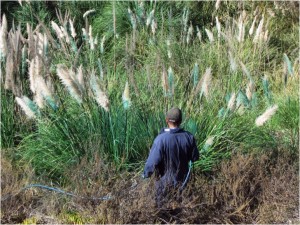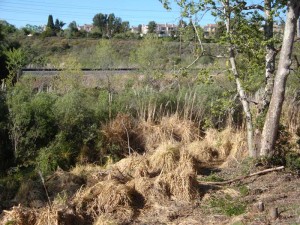Assessment Recommendation 2.2.2 suggests controlling exotic invasive species in the watershed. Here’s how we are accomplishing that.
 The State of California’s Wildlife Conservation Board provided a $330,000 grant to The Chaparral Lands Conservancy (TCLC) in 2012 to fund the Rose Creek Watershed Invasives Control Project. Friends of Rose Canyon provided an additional $50,000 to help with the removal of invasive trees in Rose Canyon.
The State of California’s Wildlife Conservation Board provided a $330,000 grant to The Chaparral Lands Conservancy (TCLC) in 2012 to fund the Rose Creek Watershed Invasives Control Project. Friends of Rose Canyon provided an additional $50,000 to help with the removal of invasive trees in Rose Canyon.

Licensed contractors mixed blue dye into the herbicide to keep track of which plants had been sprayed.
TCLC obtained all necessary permits and approvals and contracted with a licensed and insured management company to carry out the invasive plant control. Licensed workers treated the plants by applying glyphosate-based herbs (similar to Roundup) which were certified by the US Environmental Protection Agency for use in and around wetlands). Plants were left standing for 2-3 months to allow the herbicide to fully treat the roots and any re-sprouted plants were re-treated when needed. Dead plants located within 100 feet of structures were cut and removed to reduce fire risk, and dead trees were removed from the flood control channel in lower Rose Creek.
The project lasted two years and resulted in the control of 14 acres of pampas grass and other invasive plants and 8.7 acres of invasive Eucalyptus trees and Brazilian peppertrees. Additionally, North County Transit District controlled 3.4 acres of pampas grass along the railway corridors in support of the project.
“This was a big job by a great team that results in removal of some really nasty invasive plants from a total of over 26 acres in the Rose Creek Watershed”, said David Hogan, Director of TCLC.
Native plants will soon recolonize the treated areas, resulting in multiple benefits including decrease fire risk, reduced erosion, and improved water quality. TCLC is seeking funding to treat non-native plants in additional areas that were not reached.
TCLC’s Rose Creek Watershed Invasive Plant Control Project webpage for more information.

One year after the initial spraying, the dead leaves of the pampas grass plants are decomposing and will eventually allow room for native plants to flourish.
This project would not have been possible without the cooperation and assistance from all of the public and private landowners who allowed our contractors to access their property to conduct this important work. The Rose Creek Watershed Alliance and TCLC would like to thank the following public agencies, businesses and organizations:
- Anheuser Busch
- CalTrans
- City of San Diego
- Genesee Highlands Association
- Inland Industries
- La Jolla Colony Community Association
- Lucera UTC
- Metropolitan Transit System
- Pacific Woodlands
- Pennant Village Homeowner Association
- Playmore Terrace West
- Renaissance La Jolla Community Association
- San Diego Gas & Electric
- San Diego Unified School District (University City High School )
- Santa Fe Street Associates
- Trilogy Real Estate Management
- Westwood Apartment Homes
- Willmark Communities
